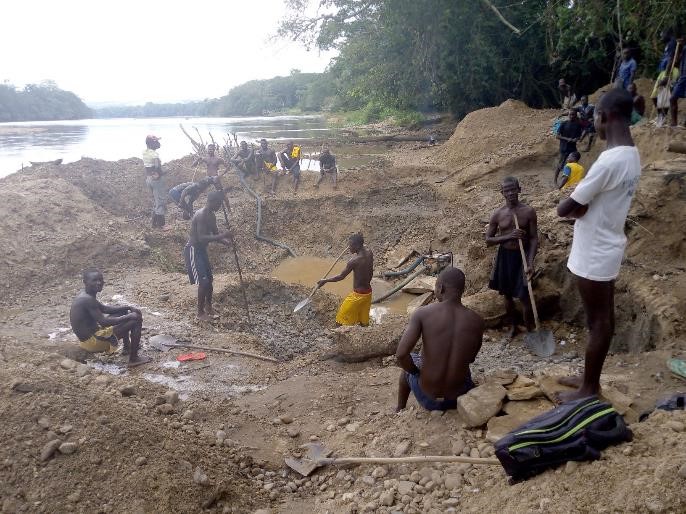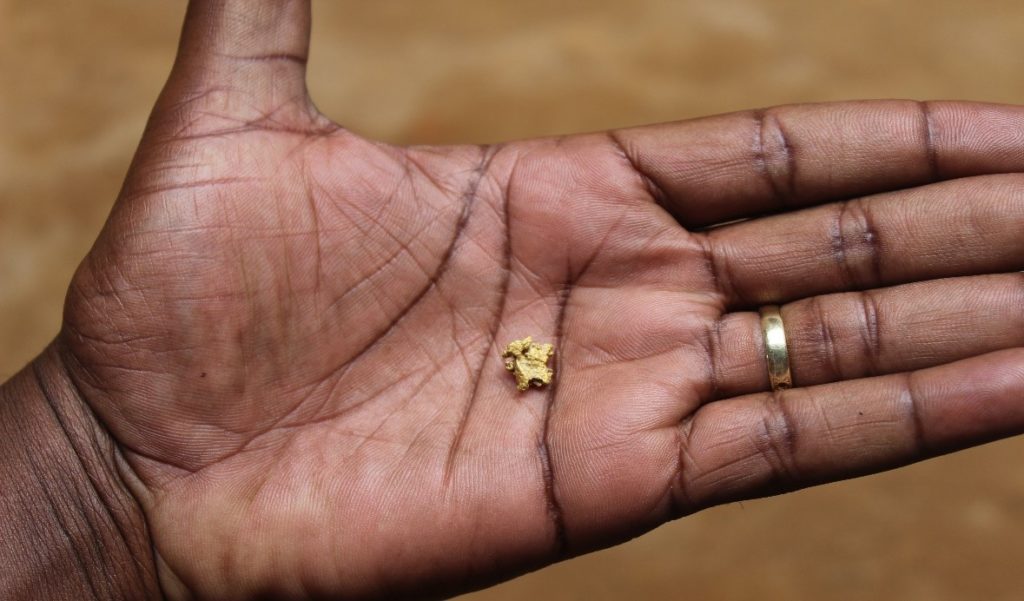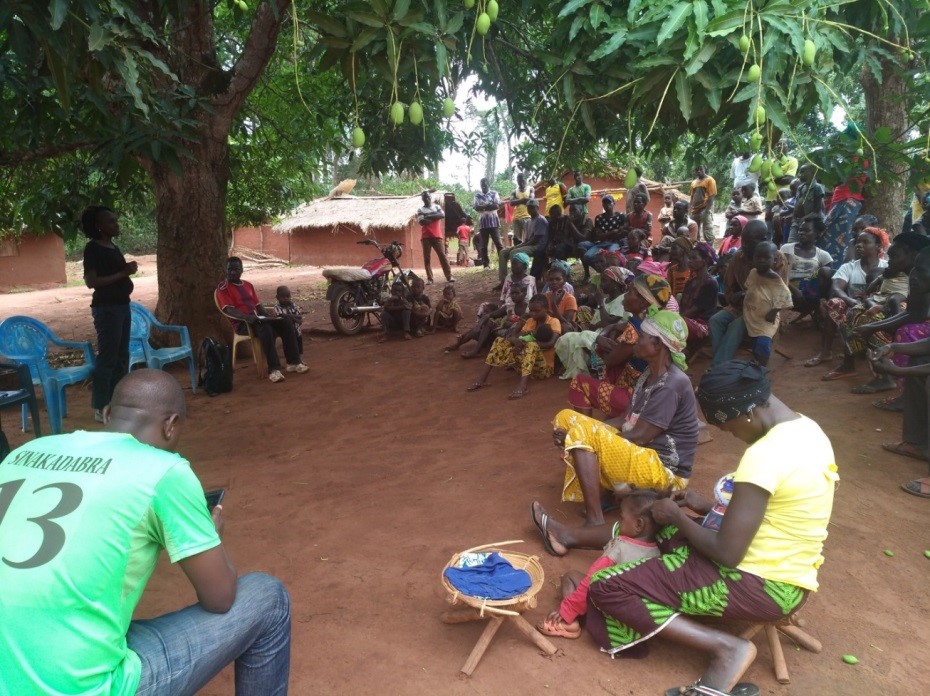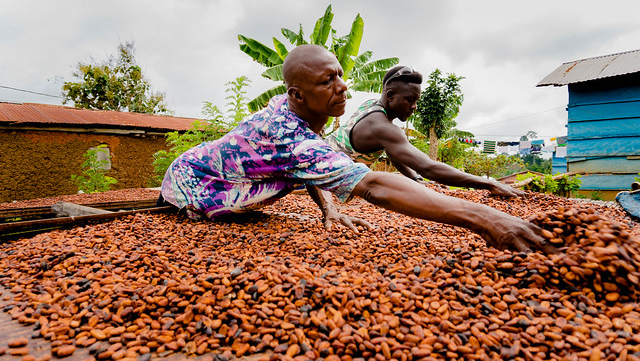Executive Summary
The USAID AMPR project conducted a baseline survey of the knowledge, attitudes and practices of artisanal miners in 9 sub-prefectures in southwestern CAR in May 2019. The purpose of the survey was to provide basic information to help measure the impact of the project as well as to better plan the project activities in collaboration with the Central African government. The target population of the survey was the artisanal miner site manager (chef de chantier), as these actors constitute the vital link between the laborers and the buyers, making them key actors to target in communication campaigns.
A sample of 341 artisanal miners was established based on a target error margin of 5% and an estimated population size of 2,400 site managers in the target area. The sample was stratified by subprefecture based on the level of activity as measured during geo-referencing campaigns under the USAID DPDDA I and DPDDA II project. A total of 13 enumerators administered the questionnaire over 3 weeks, under the supervision of the Monitoring and Evaluation Coordinator and the Artisanal Mining Specialist, with the involvement of the Project Technical Advisor. The questionnaire was developed based on previous surveys and also tested in the field in Carnot in collaboration with the government (SPPK).
Artisanal miners are relatively older than the general population at 41 years of age with a household size of about 9 people. The miners have on average 2 active sites, 5 sites in reserve, and 3 mined-out sites. They are almost all the owners of these sites, and most have inherited them from relatives, demonstrating the extent of customary land control exercised by artisanal miners in CAR. Three-quarters showed a perception of tenure security as defined by USAID. More than half have documents to demonstrate ownership, including certificates issued by the DPDDA I project, but most of the documents are informal.
Agriculture and mining have an almost equal place as a source of income. Just over half cited mining as their primary source of income, and of these almost 90% cited agriculture as the second largest source. Similarly, for the one-third of respondents who cited agriculture as their primary source of income, mining was the second largest source of income for most of them. This result confirms that artisanal miners work in a mixed rural economy dominated by these two interconnected activities.
The average artisanal miner works 9 months per year. On average, the miner hires 9 workers for these sites, which corresponds to 6 workers per site, taking into account average number of sites per miner. In addition to the workers—those who share in the gains of production—almost half of the miners employ temporary workers called katamans, a relatively recent phenomenon. On average the miners employ 3 katamans per worksite, and most are paid by the task accomplished rather than by day. There is a clear difference between financed and non-financed artisans in terms of their ability to hire labor: the financed miners have 7 workers per site on average while the non-financed only 5 workers.
Women represent a minority at all levels. Only 5% of site managers are women, and often they let men manage the day-to-day operations of the site. However, 16% of respondents say they have female workers who work for them, but when taken as a proportion of the total number of workers, only 3% are women. Women are most often involved in gold panning. In fact, 22% of respondents practice gold panning in addition to diamond mining, and this is not limited to a specific subprefecture but occurs in all areas. The extraction of gold is limited to about 0.5 grams per week, according to the responses of the site managers.
About two-thirds of the miners are financed by someone, but less than half of these financiers are licensed collectors. Most are informal buyers or other people such as relatives or shopkeepers in the villages. This finding calls into question the “classic” supply chain pattern, in particular by confirming the existence of actors, working between official collectors and miner, and who are not part of the official supply chain. Similarly, only 70% of the financed miners sell to their financier, suggesting that the financier may be a financier who does not buy, which is not consistent with what is normally assumed about them.
Most of the smaller tools (shovels, jigs, crowbars and machetes) are the property of the miner. Only 14% have water pumps that they own, while 24% of financed miners receive water pumps from their financiers. Financiers also provide small equipment, but only for about half of financed respondents. Two-thirds of the financed miners receive money to pay workers’ rations, which are on average 5,000 XAF ($ 11[1]) per worker per week. A quarter also receive support for health costs.
In terms of the sharing of earnings, most of the artisanal miners sell the stones and then share proceeds with the workers. The team leader is usually present during these negotiations and sales. In some cases, it is the team leader who leads the negotiation. According to the survey, about half of the respondents found stones in 2018, and only one-third between January and May 2019. The average weight in 2018 was 69 points[2] and 87 points in 2019. The average number of carats found by miners in 2018 is 8.35 and only 2.51 in 2019. These figures likely undercount the smaller stones given the relatively high average weight and the very high price per carat, 211,490 XAF ($ 385) per carat in 2018 and 379,929 XAF ($ 690) in 2019. Assuming an estimated 2,400 site managers in the study area, production in 2018 was 20,000 carats, which is almost certainly lower than in reality. Respondents are also likely to underreport during the survey.
Despite this problem of reliability of production data, the difference in terms of average price per carat between financed and non-financed miners is striking and consistent. On average, the non-financed earn between 30 and 50% more for their stones, according to the figures of the study. We note that “financing” takes many forms, not just monetary advances, but many types of repayment requirements. The same trend was observed for both years. This partly explains the fact that 75% of respondents said they prefer to be independent rather than financed, even though the most cited complaint was the need for financing. By this we can understand that while financing is essential for increased productivity, miners hope for modes of financing which will allow them to become independent.
Among those who are already self-financing (one-third of artisans), revenue from mining activities is the most important source of funds, followed by funds from other activities, particularly agriculture. This finding supports the need to think of alternative modes of financial empowerment, including the pooling of risks and materials and the diversification of activities. Even though there are approximately 350 mining cooperatives in the Central African Republic, only 3% of respondents are part of one, showing the gap between official cooperatives and the realities on the ground.
In terms of the level of legality, only 18% have a valid license (patente), even though 53% say they have had to pay the license in the past, and almost everyone knows the legal need to have one. Indeed, almost everyone knows the need to have the license, the need to note the production and the need to have a sales slip. The most cited reason for not getting the license was the lack of production and income to pay for it. Most respondents cited divergent prices for the license, suggesting confusion on this point or a possibility of a price premium applied by officials.
Regarding the sales slips, a quarter of respondents say they received a slip in 2019, and another quarter did not (the remainder refused to respond). According to respondents, many buyers offer a better price without slips or they prefer to issue slips only for large stones. It is also interesting to note that although a minority (14%) maintain an official production book, half have unofficial records called “site notebooks” where they record expenses, worker information and production. This could be a key source of information if the level of trust increases between the government and the producers.
Indeed, there are many informal taxation practices, according to the survey, with three-quarters of respondents reporting giving something to the village chief after findings, and half to a state authority. The Mayor (township) is the first recipient of such “gifts,” followed by USAF and the Mining Administration. The study confirmed the practice of levying an amount on “big stones” by the Administration, but less than 20% of miners reported this practice. Similarly, only 16% say they have to pay something at roadblocks. In general, two-thirds of respondents say they are satisfied with the administration in its management of the sector. Only 30% received a visit from a state agent in 2018 and 2019, and among those who received one, the SPPK focal points were the most present, showing their importance in maintaining regular contact between actors in the field and the government.
In terms of security, a minority (18%) reported issues on their mine sites or when traveling to town to sell their stones (26%). About half of respondents said they felt security had improved compared to last year. About two-thirds of respondents (71%) reported no issues of conflicts this year, and of those who had experienced a conflict, the majority said they were around site boundaries. Indeed, among all respondents, 20% said they experienced a conflict around a site boundary last year, confirming the importance of clarifying property rights about mining claims, especially as outsiders increase their presence with support of elites from Bangui. In terms of workplace accidents, only 12% reported an issue, the majority being minor injuries, though a few serious cases were reported including a drowning and a fatal snake bite.
In general, the basic knowledge level on the Mining Code and KP is average with 35% of respondents having met the criteria of the USAID AMPR project to be considered as having a basic level of understanding. Nevertheless, there is a need to improve knowledge about the definition and role of the Kimberley Process and child labor, where a quarter have said that children younger than age 14 can work, and only 3% were able to define the PK. On the other hand, almost all respondents identified documents for legality and traceability, even if only 30% identified buying houses as the exporting entity.
In terms of geology, the level of knowledge is good with respect to some evaluation criteria, even if the terminologies are not in line with international best practice. For example, the majority know that a colored diamond is worth more than a white diamond, all else being equal. However, there is a diversity in knowledge levels, with half not knowing basic categories such as “triages” and “mêlées” used by local buyers. In addition, only 15% were able to say what diamonds are used for, and most have asked for training in evaluation. Only 4% said that the prices received for their stones were fair.
As far as recommendations, the report identifies several based on the results, including the need to organize feedback and discussion workshops for the Mining Administration and for the miners themselves. Given that the project had difficulties where respondents expressed their fatigue with the large number of questionnaires, a feedback session could help to communicate on the use of the information. In addition, the study has implications for the review of the legal chain of custody, the strategy of fighting fraud and the strategy of land formalization and economic diversification. In this way the technical discussions and activities can be based on observed and measured realities.
[1] An average exchange rate of 550 XAF to the USD was used throughout this report.
[2] A point is a hundredth of a carat, so 69 points is 0.69 carats






 Ghana and Cote d’Ivoire together produce two-thirds of the world’s cocoa. Cocoa plays a critically important role in the local and national economies, providing jobs, improved livelihoods and social welfare, expanded tax base, family and corporate income, and foreign exchange earnings growth. However, the long-term viability of cocoa farming is at risk in many parts of Ghana and Cote d’Ivoire due to climate change
Ghana and Cote d’Ivoire together produce two-thirds of the world’s cocoa. Cocoa plays a critically important role in the local and national economies, providing jobs, improved livelihoods and social welfare, expanded tax base, family and corporate income, and foreign exchange earnings growth. However, the long-term viability of cocoa farming is at risk in many parts of Ghana and Cote d’Ivoire due to climate change